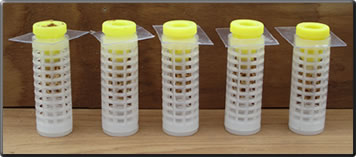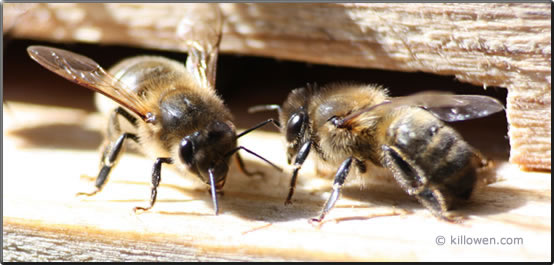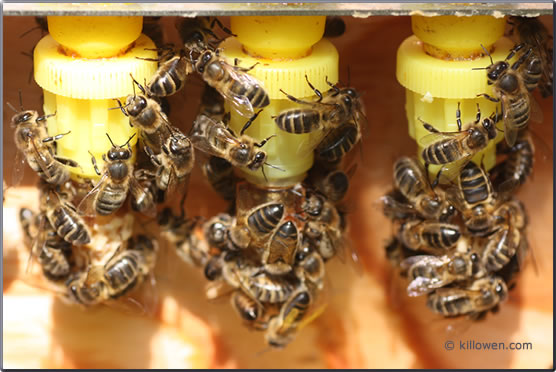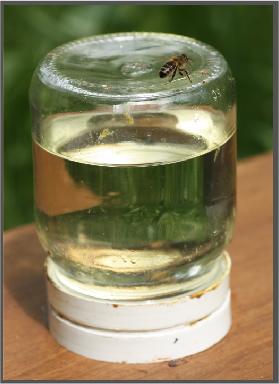Nucs
The Nucs
The nucs are made up either in standard 5 frames nuc boxes or in specially adapted brood boxes which are divided into 2 bee proof sections.
click for more info
click for more info
The Jenter plugs with the 5 queen cells in cell cages ready to go into the nucs

Three of the queens cells on the cell bar frame with attendant bees
Guard bees at the nuc entrance
Making up the nucs
On the 12th day five frame nucs are made up.
Each nuc contains two frames of mature brood and the accompanying nurse bees, sandwiched between two frames of stores and one frame of foundation. The nuc is placed on top of the hive which eventually will be requeened and from which the sealed brood frame and nurse bees were taken. The nucs are made up in the evening so that by the next day each nuc has acquired its own identity and is readily to accept a queen cell (after 24 hours or so) without danger of the cell being attacked or pulled down.
(Sometimes it might be a problem finding sufficient brood frames to make up the number of nucs required. The opportunity might then be taken to use the brood frames from a colony with an unsuitable queen. After which the queen is killed and a queen cell placed in the hive with two remaining brood frames and two frames of stores. This colony retains all the foragers and will soon rebuild after the new queen has mated.)
On the 12th day five frame nucs are made up.
Each nuc contains two frames of mature brood and the accompanying nurse bees, sandwiched between two frames of stores and one frame of foundation. The nuc is placed on top of the hive which eventually will be requeened and from which the sealed brood frame and nurse bees were taken. The nucs are made up in the evening so that by the next day each nuc has acquired its own identity and is readily to accept a queen cell (after 24 hours or so) without danger of the cell being attacked or pulled down.
(Sometimes it might be a problem finding sufficient brood frames to make up the number of nucs required. The opportunity might then be taken to use the brood frames from a colony with an unsuitable queen. After which the queen is killed and a queen cell placed in the hive with two remaining brood frames and two frames of stores. This colony retains all the foragers and will soon rebuild after the new queen has mated.)
On making up the nucs it is essential that the queen is not transferred with the nurse bees by mistake. If the queen cannot be seen, then the following procedure can be followed:
On transferring the frames from the main body brush off all the bees.
Place the frames in a new brood body over a queen excluder over the main colony and leave for 30 minutes.
Nurse bees will come up to cover the brood after which the frames can be removed and placed in the nuc.
On transferring the frames from the main body brush off all the bees.
Place the frames in a new brood body over a queen excluder over the main colony and leave for 30 minutes.
Nurse bees will come up to cover the brood after which the frames can be removed and placed in the nuc.


On the 14th day the Jenter plug holding the queen cell is suspended adjacent to the brood frame using a plastic adapter. The queen expected to emerge two days later.
The mature brood meanwhile is emerging and leaving behind empty cells for the new queen to lay up. The newly emerged bees provide the young bees that attend the queen and her new brood.
Apart from feeding, the nucs are now left alone for 3 weeks before the first examination. If the operation is successful then the mated queen can be found and marked, and brood will be see to be present.
The small colonies are now left for the rest of the season to build up more frames being added as required.
The mature brood meanwhile is emerging and leaving behind empty cells for the new queen to lay up. The newly emerged bees provide the young bees that attend the queen and her new brood.
Apart from feeding, the nucs are now left alone for 3 weeks before the first examination. If the operation is successful then the mated queen can be found and marked, and brood will be see to be present.
The small colonies are now left for the rest of the season to build up more frames being added as required.
Feeding the Nucs
It always pays to feed a nuc.
The newly made up nuc will be devoid of foraging bees and so must be self sufficient in its own stores. These can be used up quite rapidly so it is prudent to feed until the nuc does becomes self sufficient.
The photo shows a 1 lb honey jar feeder. The thick syrup is made up in the ratio 2 lb. sugar dissolved in 1 pint warm water. This should be given in the late evening so that the bees take the syrup down overnight.
A nuc is very vulnerable to robbing. If there is a dearth of forage the nuc is unable to protect itself if robbers detect an easy supply of syrup. It is prudent to take away the syrup during the daytime if robbing is suspected.
It always pays to feed a nuc.
The newly made up nuc will be devoid of foraging bees and so must be self sufficient in its own stores. These can be used up quite rapidly so it is prudent to feed until the nuc does becomes self sufficient.
The photo shows a 1 lb honey jar feeder. The thick syrup is made up in the ratio 2 lb. sugar dissolved in 1 pint warm water. This should be given in the late evening so that the bees take the syrup down overnight.
A nuc is very vulnerable to robbing. If there is a dearth of forage the nuc is unable to protect itself if robbers detect an easy supply of syrup. It is prudent to take away the syrup during the daytime if robbing is suspected.
